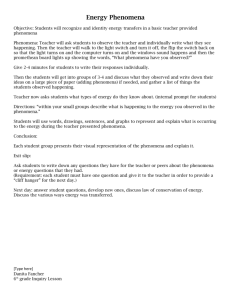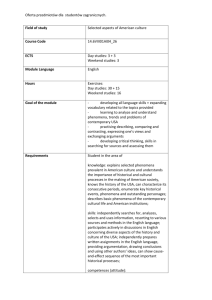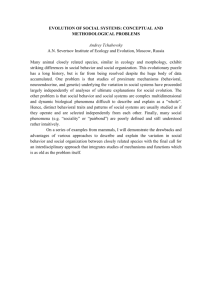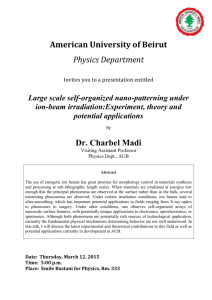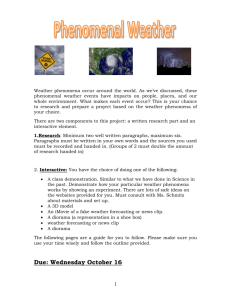Front Matter Final - Mirror Margins
advertisement
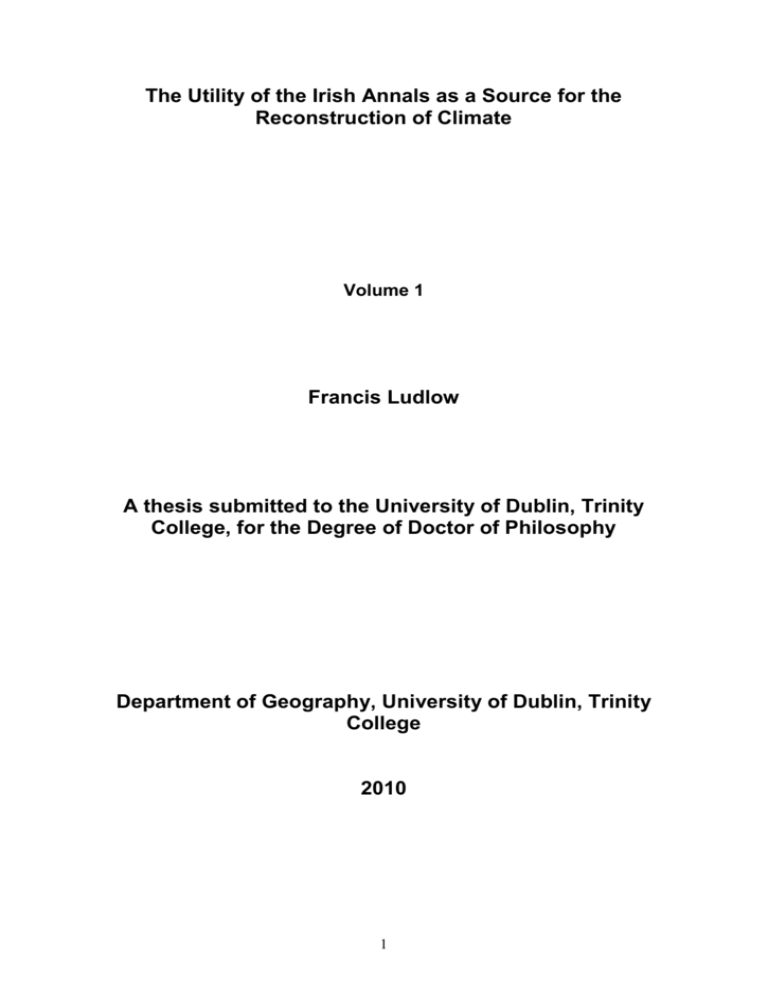
The Utility of the Irish Annals as a Source for the Reconstruction of Climate Volume 1 Francis Ludlow A thesis submitted to the University of Dublin, Trinity College, for the Degree of Doctor of Philosophy Department of Geography, University of Dublin, Trinity College 2010 1 Declaration I hereby declare that this thesis has not been submitted for a degree at this or any other university, and except where otherwise acknowledged; it is entirely my own work. _______________________ Francis Ludlow Trinity College, Dublin April 2010 2 Frontispiece: Folios 396 v and 397 r from one of the primary manuscript witness to the seventeenth century Annals of the Four Masters (MS. 1220 C iii 3, Dublin, Royal Irish Academy, ranging AM2242 to 1171AD). The manuscript is paper. Some items of interest are underlined, with original-language text and translation in corresponding coloured type taken from John O’Donovan’s edition of the these annals (i.e. Annals of the Kingdom of Ireland (O’Donovan, 1848-1851)). The text is written in Irish miniscule in Early Modern (Classical) Irish. On folio 396 v (left page): underlined in red is the AD date written in Irish for 1007AD and in green is the regnal series which is a primary element of the chronological apparatus of these annals. The yellow box highlights the use of capitals to begin entries. On folio 397 r (right page): a different scribe continues to record the entries this year as evidenced by the different style of handwriting and ink. Underlined in purple is an entry reporting great frost and snow. Underlined in black is a continuation by the scribe of the previous page. Underlined in green is the continuation of the regnal series for 1008AD. Underlined in orange is an interlineal interpolation of additional content into the original text. 3 Thesis Summary The Irish Annals are unique source for Irish history, containing annually arranged reports of important events from the early Christian to early modern periods. They are unique in Europe in their continuity of coverage, and contain reports of extreme meteorological and related phenomena and conditions, as well as information on the impacts of these on aspects of Irish society and the biosphere. Despite an awareness of the existence of these reports, and their compilation by scholars beginning in the nineteenth century, they have not been systematically exploited in climatic reconstruction, or investigation of the impacts of extremes. A comprehensive survey of published annalistic sources is undertaken and relevant content compiled and presented in this thesis in full text and condensed tabular format. The number of reported phenomena and conditions, as well as impacts associated with these are categorised and quantified according to internationally recognised classes of documentary information of use in climatic reconstruction in the discipline of historical climatology. This facilitates comparison of information in the Irish Annals with information of known utility for climatic reconstruction and provides guidance regarding the manner of climatic reconstruction to which the relevant content may be best suited. The Annals are shown to contain a very considerable quantity of reports of meteorological and related extremes, as well as impacts on society and the biosphere. Phenomena and conditions such as severe windstorms and wet seasons are well-represented and reflect known aspects of the Irish climate. Other information such as reports of difficulties in cultivation are less well represented and reflect the interests of the scribes and their situation in the predominantly pastoral economy of Gaelic Ireland. Documentary information has a number of distinct advantages over other sources of information of past climate from natural proxies. It is both precisely and accurately dated, it is unambiguous and phenomena-specific, and provides unique information regarding the impacts of extremes on society and the biosphere in the past. Documentary information also has potential limitations, including exaggeration and fabrication of reported phenomena and conditions, issues of meteorological interpretation, inhomogeneities, and discontinuities (i.e. incomplete reporting temporally and spatially). These issues, in combination, relate to the reliability and representivity of climatic reconstruction from documentary information. The central research question of this thesis asks whether the relevant content of the Irish Annals is sufficiently reliable and representative to allow credible climatic reconstruction. A systematic methodology approach is developed and applied to the assessment of the reliability of the relevant content of the Irish Annals. An essential first step in this approach is the exploration of the perception of rare natural phenomena from the Early Christian to Early Modern periods in Ireland. The overlapping conceptions of rare or unusual natural phenomena as marvels, portents and miracles is investigated and it is shown that these concepts have utility in representing the perception of extreme meteorological and related phenomena and conditions in the Annals. Knowledge of the perception of rare or unusual natural phenomena informs an assessment of the varied motives for the reporting of extreme meteorological and related phenomena and conditions in the Irish Annals. Some of these motives will result in reporting of more or less objectivity and accuracy (i.e. reliability). These motives include reporting extremes because of the spectacle value of meteorological and related extremes, their impacts on society and the III biosphere, the perceptions of these phenomena as portents or miracles and the uses to which such perceptions could be put for political, theological and financial ends, as well as a scholarly desire to maintain a genuine record of events seen as being of historic importance. A scale of apparent reliability is developed that recognises uncertainty in the assessment of reliability. The scale ranges from 0 for reported phenomena and conditions considered ‘apparently unreliable’, 1 for reports considered of ‘uncertain reliability’ and 2 for reports considered ‘apparently reliable’. The body of relevant content in the Irish Annals is quantified accorded to the number of reports placed at each point on this scale and it is shown that the vast majority of reports can be considered apparently reliable, and providing a solid foundation for climatic reconstruction from the annalistic content. However, certain types of phenomena and conditions exhibit a higher proportion of reports considered less than apparently reliable than others, and this is associated with particular perceptions of these phenomena and conditions that motivate reporting in a less than reliable manner. Reports of lightning strikes attributed to divine retribution are an example. Reports placed at point 0 and 1 on the scale of apparent reliability are not distributed evenly through time, but often concentrate in earlier periods of annalistic coverage, and may therefore constitute a potentially significant distortion of the representivity of climatic reconstruction from the annalistic content. Factors impacting upon the representivity of climatic reconstruction are further explored, and include changes in the perception of natural phenomena through time resulting in increased or decreased motivation to record such, and varying levels of record availability through time, as measured by total entry numbers per year in the available annalistic sources. It is shown that this latter factor operates as a non-climatic control on the number of reports of phenomena and conditions in the surviving annalistic sources, particularly for the earliest and latest’s periods of coverage. The seasonal and geographical representivity of the relevant content are also explored. Examining the distribution of months and seasons in which reported phenomena and conditions occurred reveals a reasonable coverage for all seasons, though coverage for autumn is weakest. An exploratory examination of places and territories referred to in connection with reported phenomena and conditions shows that the geographical focus of reports focuses strongly on those locations of known annalistic recording (e.g. Clonmacnoise) and it is not possible to compare trends in the occurrence of meteorological and related extremes for disparate regions in Ireland based upon the available information. To complement the assessment of the reliability and representivity of the relevant content, the first systematic comparison of reported meteorological and related phenomena and conditions to independent evidence from the Greenland Ice Sheet Project 2 ice-core is conducted. This shows conclusively that the majority of reported phenomena and conditions in the Irish Annals can be considered reliable and for certain phenomena and conditions (e.g. snow, frost, wind storms) reporting may be sufficiently complete to allow a broadly representative reconstruction of certain aspects of the Irish climate. IV Acknowledgements I would like to express my gratitude to my two supervisors, Mark Hennessy and David Taylor, for their support and patience. I would also like to thank Mike Baillie and David Brown, Queen’s University Belfast, under who’s supervision I consulted the Irish Oak tree ring record in 2006. I would like to thank Arlene Crampsie for her support, insight and willingness to challenge my stubborn approaches to writing, and for critically and ferociously reviewing drafts of each chapter. William Nolan for his constant tireless interest, endless encouragement, broad scholarly outlook and input into all stages of the writing of the thesis. Daniel McCarthy for his pioneering investigation of the Irish Annals, their origins and development, his immense synchronisation of the chronology of the Irish Annals, without which this thesis would not have been possible, and for allowing early access to his unpublished works. James Killen for his support, good humour and statistical guidance from my first year as an undergraduate in Geography in TCD in 1999. Paul Leahy of University College Cork for offering me the opportunity to work on the EPA funded ‘Extreme Weather, Climate and Natural Disasters’ project and for the numerous conversations about the annalistic materials and its analysis and presentation. Barry O’Dwyer for numerous conversations regarding statistical and other matters and the comparison of the annalistic information to the GISP2 ice-core record. Numerous scholars and colleagues have generously provided their time and expertise towards the completion of this thesis or otherwise helpfully commented on the material. I thank Enda Murphy for his statistical expertise, conversations on the comparison of the annalistic information and GISP2 ice-core, and uncompromising approach; Charles Travis for his help with the production of maps, general encouragement and sage advice; Gayle McGlynn for her patience and the proofreading reading of Chapters 1 and 2; Peter Coxon for his continual good humour, the use of photographs from his fine and eclectic collection and the opportunity to gain experience lecturing whilst completing this thesis; Gerald mills for providing numerous papers relating to the Irish climate; Paul Mayewski for providing data from the GISP2 and advice as to its usage; Steve McCarron for the opportunity to become involved with the Irish Quaternary Association and his help in interpreting some cryptic references to physical events in the Annals; Michael Quigley for his general support; Kieran Hickey for his advice on documentary climatic data and encouragement; Frank McDermott for providing access to the Crag Cave speleothem data and discussion of its interpretation; David Dickson and Poul Holm for their support, interest and opportunity to work on the establishment of the Irish Environmental History Network; Bruce Campbell for his encouragement, advice and belief in the material, Deb Meese for providing images of the GISP2 ice core; Laragh Larsen for reading early outlines of this thesis; Kate Southall for the use of her photographs of the 31st December 2009 eclipse; Roisin Nolan for the use of her photographs of Glendalough; Mabel Denniston for her constant good humour and patience; Terry Dunne for his various help and new shelves; Al Matthews for advice on mathematics, statistics and Microsoft Excel; Jennifer V Harwood-Smith for her expertise on language, literature and lay-out and Sorcha Ni Fhlainn for her general colourful excellence. I would also like to thank for their support and interest, Michael Monk, Bettina Stefanini, Eileen Reilly, David Drew, Ger Kiely, Patrick McCafferty, Jason McElligott, Patrick J. Duffy, Juliana Adelman, Gillian Marron, John Sweeney, Jelle Zeilinga de Boer, Sheila McMorrow, Bernadette Cunningham, Philip Lawton, Guoqiang Chu, Tricia Buckingham and Elizabeth Crowley from the Bodleian Library, Padraig O’Machain of the Irish Script on Screen project, Nikki Brauton of the Museum of London, Claire Burke of the Armada Hotel, Co. Clare, Kim Hogeland of the University of California Press, and Roberto Carniel from stromboli.net, Niall McRory, Mark Sheridan, Robert Neilson, John Kenny, Peter McClean, Roelof Goudriaan, David Murphy and Peter Loftus. I would like to thank the Irish Research Council for the Humanities and Social Sciences for awarding me their Government of Ireland Scholarship, 2004-2006; the Department of Geography for their contributions to travel expenses and Trinity College Dublin for awarding me a Trinity Postgraduate Studentship (2003-2004). I would like to thank Donnchadh Ó Corráin for permission to access the Corpus of Electronic Texts online editions of the text of the Irish Annals. I would like to thank my parents Ann and Michael Ludlow for keeping me in clothes and food throughout the years, and for supporting me throughout my education. I also thank my brother Colin Ludlow, pet cow Slobber, and my extended family. I thank William and Teresa Nolan for all of their varied and constant support and encouragement throughout the years of my thesis. Thank you! Greatest thanks must without doubt go to my fantastic, wonderful, excellent (and all other comparable adjectives) partner, Brianán Nolan, for sustaining me throughout the writing of this thesis and for keeping our sanity intact in the final torturous months. Without this support, this thesis would not exist. Finally, I wish my sister, Joanna Ludlow, could know that I dedicate this thesis to her. VI List of Abbreviations FM Annals of the Kingdom of Ireland / Annals of the Four Masters (O’Donovan, 1848-1851) AU Annals of Ulster (Mac Airt and Mac Niocaill, 1983; Hennessy and MacCarthy, 1887-1901) LC Annals of Loch Cé (Hennessy, 1871) CT Annals of Connacht (Freeman, 1944) AI Annals of Inisfallen (Mac Airt, 1944) AT Annals of Tigernach (Wilde, 1851; Stokes, 1895-1897) CS Chronicon Scotorum (Hennessy, 1866) FA Annals of Ireland: Three Fragments (Radner, 1978) AB Annals of Boyle / Cottonian Annals (Freeman, 1924-1927) MCB Miscellaneous Irish Annals – Fragment 1 – Mac Carthaigh’s Book (Ó hInnse, 1947) FR2 Miscellaneous Irish Annals – Fragment 2 (Ó hInnse, 1947) FR3 Miscellaneous Irish Annals – Annals of Oileán Na Naomh – Fragment 3 (Ó hInnse, 1947) MB Mageoghagan’s Book / Annals of Clonmacnoise (Murphy, 1896) BL Annals from the Book of Leinster (Stokes, 1887) DF The Annals of Ireland, from the Year 1443 to 1468 (O’Donovan, 1845) EA Egerton Annals (O’Grady, 1892) MG Memoranda Gadelica (Walsh, 1931) SAT Short Annals of Tirconaill (Walsh, 1934) SAF Short Annals of Fir Manach (Walsh, 1935) SAL Short Annals of Leinster (Walsh, 1936b) SAA Annala Gearra as Proibhinse Ard Macha / Short Annals of Armagh (Mac Niocaill, 1958-59) CF A Fragment of Irish Annals / Carew Fragment (Ó Cuív, 1981) VII List of Figures 1.1 Schematic of the temporal coverage in each of seven major annalistic texts, 431-1649AD. 1.2 Locations of recording of annalistic records, c.425 to c.1590AD. 1.3 Mean annual ring-widths of Irish oaks from Irish master chronology, 18011830AD. 3.1 Word counts of 15 sources surveyed, based upon original-language word counts published by CELT. 3.2 Representative page of the Master Compilation of Meteorological and Related Phenomena and Conditions in Appendix 1. 3.3 Absolute entry counts containing relevant content per annalistic source and relative percentage contribution of each source to all entries from all sources combined. 3.4 Total entry counts per seven major annalistic sources (blue bars) and the proportion of these represented by relevant entries (red bars). 3.5 Histogram showing the number of reported phenomena and conditions per entry in FM. 3.6 Schematic of categories, subcategories, and headings of reported phenomena and conditions from the Annals. 3.7 Schematic of categories and headings of reported potential dependent phenomena and conditions from the Annals. 3.8 Available reported phenomena and conditions by main categories and subcategories of relevant indirect proxy information. 3.9 Absolute counts and relative percentage values of reported phenomena and conditions per direct heading. 3.10 Absolute counts and relative percentage values of reported phenomena and conditions per indirect proxy heading. 3.11 Total reports of potential dependent phenomena and conditions by three major categories. 3.12 Absolute counts or relevant reports with relative percentage values per heading against the combined total of all headings. 3.13 Absolute counts of inferred phenomena and conditions and relative percentage values per heading in the category of direct information. 3.14 Absolute counts of inferred phenomena and conditions and relative percentage values per heading in the category of indirect proxy information. 3.15 Absolute counts of inferred dependent phenomena and conditions and relative percentage values per heading in the category 4.1 Distribution through time of reports reflecting particular perceptions of natural phenomena by six categories, 431-1649AD. 5.1 Schematic summary of considerations pertaining to assessment of reliability reported meteorological and related phenomena and conditions 5.2 Distribution of relevant reports to meteorological and related phenomena and conditions, including potential dependent phenomena and conditions, by points on scale of apparent reliability. 5.3 Histograms representing the percentages of reports per heading placed at each point on scale of apparent reliability. 5.4 Distribution of reported phenomena and conditions from which low precipitation and low temperature may be inferred, divided according to points on scale of apparent reliability. 6.1 Distribution of total reports per 20 year period from 431-1649AD as placed at each point on the scale of apparent reliability 6.2 Histogram of the frequencies of 20 year periods by total reports placed at point 2 on scale of apparent reliability. 6.3 Number of reports placed at points 0, 1 and 2 presented separately in 20 year periods from 431-1649AD VIII 18 26 43 90 101 106 107 109 111 112 117 121 122 123 128 136 137 138 193 207 of 224 230 235 238 240 242 6.4 6.5 6.6 6.7 6.8 6.9 6.10 6.11 6.12 6.13 6.14 6.15 6.16 6.17 6.18 6.19 6.20 6.21 6.22 6.23 7.1 Maximum potential erroneous inflation of total reports per period from inclusion of reports placed at point 0, 1, and 0 and 1 combined. Histogram of the frequencies of 20 year periods by maximum potential erroneous percentage inflation from inclusion of total reports places at points 0, 1 and 0 and 1 combined. Distribution through time of reports of “fire from heaven” and reports falling under the heading “thunder and lightning”. Total combined entries from seven major sources through time. Total entries and entries containing relevant information from seven major texts in 20 year periods, 431-1649AD. Scatterplot of total entries and total relevant entries per period. Distribution of months referred to or identifiable in entries reporting extreme meteorological and related phenomena and conditions, and potential dependent phenomena and conditions. Distribution of seasons referred in entries reporting extreme meteorological and related phenomena and conditions, and potential dependent phenomena and conditions. Distribution of aggregate seasonal reports from entries reporting extreme meteorological and related phenomena and conditions, and potential dependent phenomena and conditions. Distribution per 20 year period of months explicitly referred to or identifiable from entries reporting relevant phenomena and conditions. Distribution per 20 year period of seasons explicitly referred to in entries reporting relevant phenomena and conditions. Place and territory names for the reported occurrence of extremes, where identifiable within modern county boundaries, seventh to eleventh centuries Place and territory names for the reported occurrence of extremes, where identifiable within modern county boundaries, twelfth to sixteenth centuries. GISP2 SO4 sample values, 431.8AD to 1648.32AD, with potential signals of major explosive volcanism highlighted. Histogram showing the distribution of 585 samples by SO4 value. Reports from which low temperatures may be inferred for Ireland (Panel(a)) and total “years of cold” inferred from these reports (Panel(b)), per 20 year period 431-1649AD. GISP2 sample SO4 values from 431.8AD to 1649.32AD with potentially corresponding annalistic reports. GISP2 signals of potential explosive volcanism compared to annalistic years of cold. Schematic depiction of the selection of GISP2 SO4 sample values based on dates of years of cold from the Annals. Distribution of months associated with years of cold in absolute and percentage terms. Schematic overview and summary of work undertaken in thesis IX 244 246 249 253 255 256 261 262 263 265 266 268 269 277 278 280 282 284 286 288 293 List of Boxes 1.1 Censored text in the 1896 published edition of the Annals of Clonmacnoise. 1.2 Published annalistic sources, periods covered from 431AD and keys to abbreviations used hereafter in the text. 1.3 Reported environmental events and societal stresses in Irish prehistory, from FM. 2.1 Censored text in AU in TCD 1282 vs. Rawl. B. 489, 1451AD. 3.1 Representation of relevant information in the Tables in Appendix 2. 3.2 Direct, indirect proxy, and potential dependent phenomena and conditions. 3.3 Potential dependent phenomena and conditions. 3.4 Independent evidence of causal phenomena and conditions, 917AD. 3.5 Inferring poor harvests from available information. 3.6 An example of persistent formulaic vocabulary and phraseology. 3.7 An example of inconsequential and minor variation in translation. 3.8 Variation in translation, “inclement/harsh/bad weather” vs. “stormy weather”. 3.9 Variation in translation of “mes” and translation of other fruit 3.10 Duplicated entries in CS and FM for 700AD 3.11 Variant duplicate entries from FM and AU, 818AD. 4.1 Marvels and wonders in the Annals. 4.2 Relevant Irish words and phrases for marvels and related concepts. 4.3 Relevant astronomical phenomena reported in the Annals. 4.4 Miraculous occurrences in the Annals. 4.5 Motives for reporting meteorological and related phenomena and conditions. 4.6 Lightning in 772AD and the Last Days. 4.7 Astronomical phenomena portending societal stresses. 4.8 Determining divine opinion, demonstrating morals and Church authority, 1050AD 4.9 Nealle Frassagh and the “three showers” as reported in MB, 764AD. 4.10 Environmental phenomena as miracles in the Vita Columba. 4.11 Saints’ miracles and saintly interventions in the Annals. 4.12 Meteorological phenomena commemorated by verse, and comparisons between years. 4.13 Meteorological and related phenomena for dramatic and plot purposes. 4.14 Variant descriptions of the death by lightning of Lughaidh. 4.15 Obits of the kings of Tara, 879AD and 980AD. 4.16 Births and deaths caused by or associated with natural phenomena. 5.1 Brian Mac Diarmada’s and Thomas Le Strange’s report of the hail in Elphin, 1587/1588AD. 5.2 Unique entries with reported phenomena and conditions of full “apparent reliability”. 5.3 Entries with reported phenomena and conditions of “uncertain reliability”. 5.4 Entries with reported phenomena and conditions considered “apparently unreliable”. 6.1 Lord George Byron’s poem ‘Darkness’ inspired by the conditions of 1816. X 14 15 24 64 103 115 125 133 135 139 140 141 143 147 150 155 156 158 164 168 169 171 173 176 182 183 185 187 197 201 202 208 213 219 222 273 List of Tables 3.1 Absolute and relative number of reported phenomena or conditions 3.2 Direct and indirect proxy phenomena and conditions: absolute values and relative percentages. 3.3 Dependent phenomena and conditions, absolute and relative percentages. 4.1 Categories of reports reflecting perceptions of natural phenomena through time. 5.1 Reports and observations by heading and assigned reliability. 6.1 Periods from 431-1649AD in which the total number of reports placed at points 0 and 1 equal or surpass the number of reports placed at to point 2. XI 116 119 127 192 227 239 List of Plates 1.1 Vellum page from the fourteenth century manuscript of the Annals of Tigernach with chronological notations and relevant content highlighted 2.1 The River Strule in Omagh, Co. Tyrone, frozen 25th December 2009. 2.2 Illustration of flagellants at Doornik, Belgium, 1349AD. 2.3 Inscriptions recording flood heights on the façade of the church of Santa Maria sopra Minerva, Rome, Italy. 3.1 Page 95 of Wilde’s (1851) Tables of Deaths from the Census of Ireland 1851. 3.2 Round tower at Fertagh/Grangefertagh, Co. Kilkenny. 3.3 Roscrea round tower, with first floor window facing East. 3.4 Remains of liquefied peat from flow in drainage channel downslope of source (a) and inundated GAA pitch on floodplain below (b). 4.1 Woodcut of the “monk-calf” by Lucas Cranach, 1523AD 4.2 Aurora borealis over Scotland. 4.3 Sixteenth-century depiction of St. Columba from the Beatha Colaim Chille (i.e. “Life of Colum Cille”). 4.4 Spectators on the bridge and roadside enjoy the spectacle of the River Suir in flood. 4.5 Art’s Cross, in the area of the Wicklow Mountains known as the Flag’s. 4.6 Partial lunar eclipse, December 31st, 2009, visible in Europe, Africa, Asia, the Middle East and Australia. 5.1 Picture of the Upper and Lower Lakes of Glendalough looking east. 6.1 Lithograph representation of the eruption of Mt.Vesuvius, 1631AD. 6.2 One metre section of the GISP2 from 1885 metres depth. XII 37 53 69 77 93 126 131 134 167 172 181 184 190 200 218 275 276 Table of Contents: Volume 1 List of Abbreviations VII List of Figures VIII List of Boxes X List of Tables XI List of Plates XII Chapter 1: Introduction Page 1.1 Central Research Question and Aims 1 1.2 Thesis Outline and Structure 4 1.3 Historical Climatology: Definitions, Objectives, Development 8 1.4 The Irish Annals 11 1.4.1 Introduction, Editions Surveyed and Temporal Coverage 11 1.4.2 First Contemporary Content and General Reliability 19 1.4.3 Locations and Provenance of Recording 24 1.4.4 Purpose, Function and Motivation for Irish Annalistic 29 Recording 1.4.5. The Chronology of the Annals 35 1.5 Importance and Context of Research 40 Chapter 2: Reliability and Meteorological Interpretation of Documentary Information 2.1 Introduction 49 2.2 Early Historical Climatology and the Contemporary Sources Rule 51 2.3 Purpose, Function and Motive 57 2.4 Historical Perception and Interpretation of Phenomena and Conditions 66 2.5 Meteorological Interpretation of Reports 72 2.6 Historical Source and Textual Criticism 82 Chapter 3: Content Analysis of Meteorological and Related Information in the Annals 3.1 Introduction 89 XIII 3.2 Existing Surveys of the Annals and Outline of New Survey 92 3.2.1 Utility of Previous Surveys of the Annals 92 3.2.2 Outline and Scope of New Master Compilation 98 3.2.3 Survey Procedure: Index and Electronic Searches and 103 Complete Reading 3.3 Categorisation and Quantification of Weather and Related Information 105 3.3.1 Approaches to Quantification and Diversity of Information 105 3.3.2 Direct and Indirect Proxy Phenomena and Conditions 115 3.3.3 Dependent Phenomena and Conditions 123 3.4 Ambiguous, Indeterminate and Inferred Phenomena and Conditions 3.4.1 Inferring Phenomena and Conditions from Ambiguous 130 130 Information 3.4.2 Quantifying Inferred Phenomena and Conditions 136 3.4.3 Ambiguity and Indeterminacy in Translation 138 3.5 Textual Criticism and Witness Status 144 Chapter 4: Motivations for Recording Natural Phenomena 4.1 Introduction 151 4.2 Perception of Natural Phenomena 152 4.2.1 Natural Phenomena as Marvels 152 4.2.2 Natural Phenomena as Portents and Signs 157 4.2.3 Natural Phenomena as Miracles 162 4.3 Motives for Recording Meteorological and Related Content 167 4.3.1 Overarching Motives for Recording 167 4.3.2 Determining Future Events 168 4.3.3 Determining Divine Opinion, Demonstrating Morals and Church 172 Authority 4.3.4 Exploitation for Political, Financial and Theological Purposes 178 4.3.5 For Emphasis, Pure Spectacle, Historic and Impact Value 183 4.3.6 For Literary and Narrative Purposes 186 4.3.7 Dedicated and Incidental References 190 4.4 Perceptions and Change through Time 191 4.4.1 The Need to Explore Change through Time 191 4.4.2 Changing Eschatological Expectations 194 4.4.3 Ecclesiastical to Secular Recording 198 XIV Chapter 5: The Reliability of Relevant Annalistic Content 5.1 Introduction 204 5.2 Assessment and Scale of Apparent Reliability 205 5.2.1 Rationale and Utility of Scale of Apparent Reliability 205 5.2.2 Examples at Point 2 on Scale 211 5.2.3 Assessment and Assignment to Point 1 on Scale 214 5.2.4 Examples at Point 0 on Scale 219 5.3 Quantifying Phenomena and Conditions by Apparent Reliability 223 5.3.1 Total Relevant Content by Point on Scale of Reliability 223 5.3.2 Reliability per Phenomena/Conditions Headings 226 Chapter 6: The Representivity of Relevant Annalistic Content 6.1 Introduction 237 6.2 Temporal and Geographical Representivity of Relevant Content 237 6.2.1 Impact of Reliability on Representivity 237 6.2.2 Influences on the Representivity on Reconstructed Trends 248 6.2.3 Impact of Record Availability of Reconstructed Trends 251 6.2.4 Monthly and Seasonal Representivity 259 6.2.5 Geographical Representivity 267 6.3 Relevant Content and Independent Evidence 270 Chapter 7: Summary Discussion and Conclusion 7.1 Overview of Research 289 7.2 Guidance in Historical Climatology 294 7.3 Limitations and Future Research 296 7.4 Conclusions 299 XV



